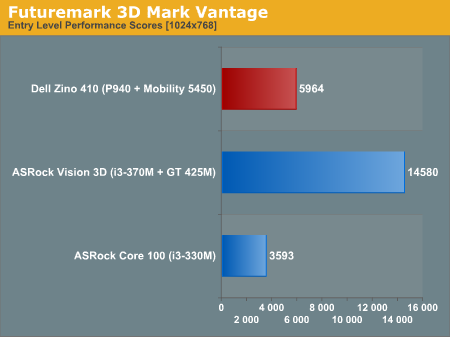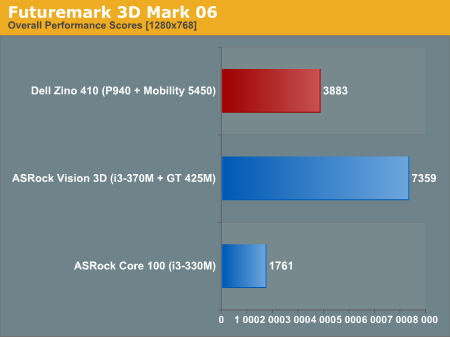Dell Zino HD 410 HTPC Review
by Ganesh T S on February 19, 2011 7:08 AM EST- Posted in
- HTPC
- Dell
- AMD
- Media Streamer
- ATI
The whole purpose of adding the discrete GPU to the Zino 410 was to make sure that the shortcomings of the integrated 4200 series GPU wouldn't be noticed. The Zino 410 provides only one option, namely, the Mobility 5450. How good is it?
We ran the 3D Mark Vantage and 3D Mark 06 benchmarks and the graphs below show how the Mobility 5450 fares when compared to the iGPU of the Core 100 and the GT 425M of the Vision 3D.


The Zino 410 comes in between the Core 100 and the Vision 3D in terms of 3D benchmarks. It is, in fact, closer to the Core 100. This further stresses the fact that the 5450 is only a very marginal improvement over the Intel integrated GPUs with respect to graphics performance.
However, the run-of-the-mill graphics performance is not of much concern to many HTPC users. HD video decoding offload is more important. The Mobility 5450 has the UVD2 decoder engine. UVD2 supports complete hardware decoding of all codecs except for MPEG2, Real Media, On2 codecs.
Here is where the downer comes in. While going through our media streamer test suite, we found that many 1080p60 H264 clips wouldn't play properly. We had protracted communication with both Dell and AMD, and it was one of the main sources of delay with respect to the publishing of this review. We waited quite a bit to see whether driver updates would fix the issue, but release after release went by without any improvement in the situation. After Catalyst 11.1, we gave up.
The short story is that the HD 5400 series (Cedar based) is qualified for content up to 1080p 24fps only. At that format all the video quality features are available with the exception of mosquito noise reduction and deblocking. Anything beyond that format is not qualified for the Mobility 5450. Even though some instances of that format (1080p30 or 1080p60 H264) may play back, it's not guaranteed that it will be smooth.
All in all, the Mobility 5450 falls short in its support for certain encodes when compared with its midrange and high end cousins, as well as the nVidia 4xx GPUs and Intel HD Graphics. Some of the benchmarks show that the graphics performance ought to be better than Intel HD Graphics. In the next section, we will see whether it is true in real world gaming.











69 Comments
View All Comments
silverblue - Saturday, February 19, 2011 - link
...would having two differently-sized SO-DIMMs have on system performance?I'd be tempted to take replace that 4GB module with a 2GB one just to see what happens. 6GB of RAM just doesn't compute. :)
We seem to be getting a decent number of Dell-AMD systems lately... I only hope they take up Brazos with the same level of enthusiasm, because even if it did result in a small drop in performance, this review would've been largely the same in terms of gaming and video playback/quality, albeit with a much smaller footprint. Also, in that scenario, dual channel wouldn't matter as Fusion doesn't support it.
fabarati - Saturday, February 19, 2011 - link
If AMD has anything like Intels asynchronous dual channel, the first 4 GB will perform like dual channel, whilst the remaining 2 GB will perform like single channel.Taft12 - Saturday, February 19, 2011 - link
Dual-channel memory was a scam from the beginning that has somehow survived to this day to make PC buyers think they needed to buy more memory than needed.Have you seen the benchmarks? ~1-2% benefit AT MOST for anything that's not a synthetic memory bandwidth test, regardless of platform.
http://www.tomshardware.com/reviews/PARALLEL-PROCE...
fabarati - Saturday, February 19, 2011 - link
Didn't it help back in the P4 and/or P-M days? And how did it do in early Athlon 64 days?But yeah, Core Duo and newer doesn't really benefit from Dual channel, one
silverblue - Saturday, February 19, 2011 - link
Theoretically, dual channel would help APUs as they're bandwidth-limited.I suppose you're right about standard usage though, even raising memory clocks doesn't make for a sizeable performance advantage.
asmoma - Saturday, February 19, 2011 - link
Starcraft 2 is not a synthetic memory test, and it does benefit from going from 2 to three channels, just read some performance reviews of Starcraft 2.DanNeely - Saturday, February 19, 2011 - link
The einstien@home applications benefitted from a 3rd channel on i7 quad cores; and the 2nd channel on C2 quads as well; high performance server farms/clusters/super computers are a significant segment of the market. On the i7-quad, E@H had a 66% speedup from the 2nd channel, and a 5% gain from the 3rd. Sandybridge gave a similar speedup from the 2nd channel. I can't find the thread with the C2Quad results, but IIRC they were a 10-25% speedup.http://einstein.phys.uwm.edu/forum_thread.php?id=8...
I don't have benchmarks handy, but I suspect a heavily loaded DB server would also benefit from the extra memory bandwidth because the queries would result in a psudorandom memory access pattern that would limit the ability of the cache controller to prefetch most of the data being requested.
jeremyshaw - Friday, March 4, 2011 - link
that actually had to do with uncore clocks, not memory channels.vailr - Saturday, February 19, 2011 - link
How would a Mac Mini compare?Could a Mac Mini be retrofitted with a Blu-Ray drive (since Blu-Ray is available factory installed) and then run as a Windows HTPC?
tipoo - Saturday, February 19, 2011 - link
Why on earth would you buy a Mini to run as a Windows HTPC? You'd pay more for less performance.